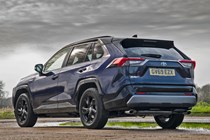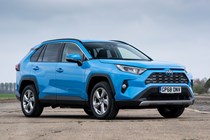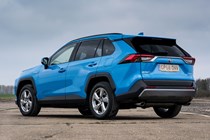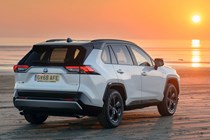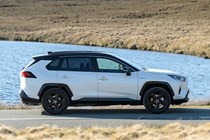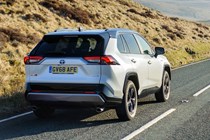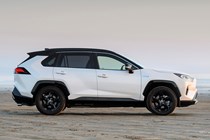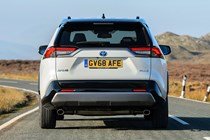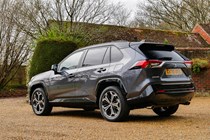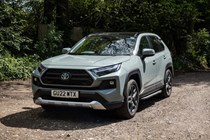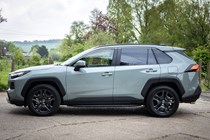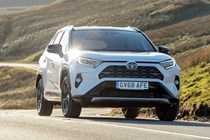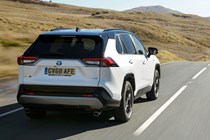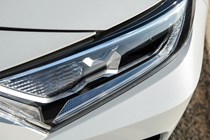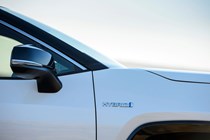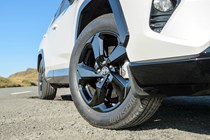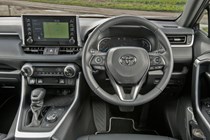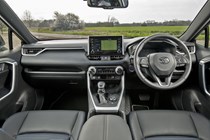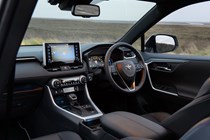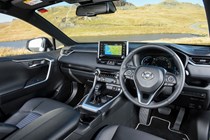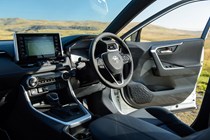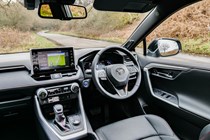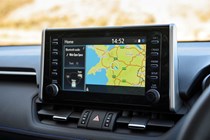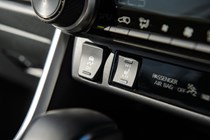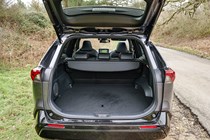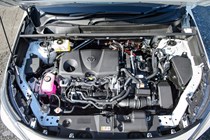
Toyota RAV4 engines, drive and performance
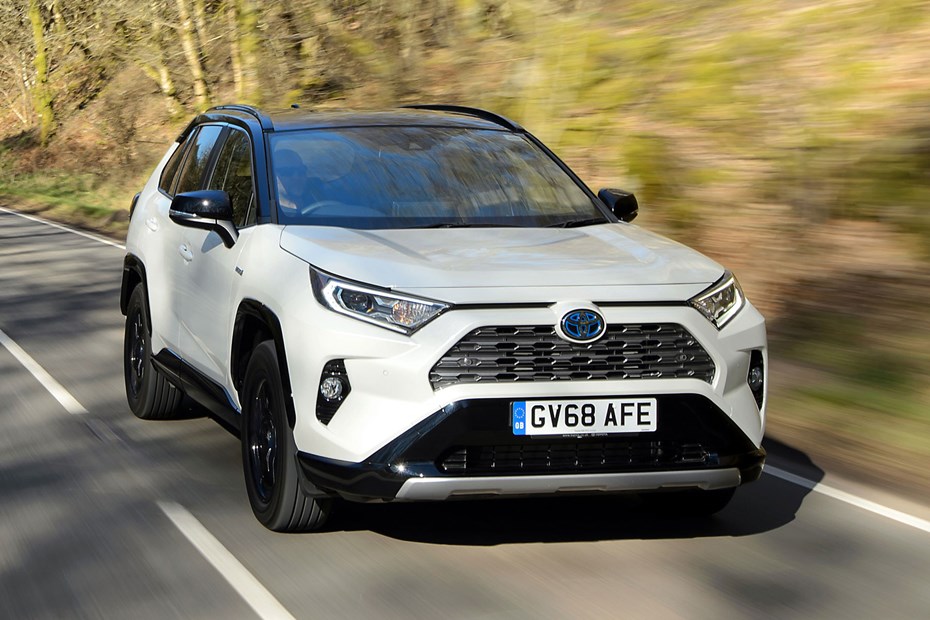
- Self-charging or plug-in hybrid options
- Automatic transmission is standard
- Choice of front- or all-wheel drive
Hybrid engines
There’s a petrol hybrid drive system available with either front- or four-wheel drive. Toyota calls it a self-charging hybrid because you don’t have to plug it in. The separate plug-in version is only available with four-wheel drive. This offers the highest performance, the best economy and the lowest emissions, but there’s a significant price difference of about £11,000 between the standard hybrid and the plug-in model.
The regular hybrid setup uses a 2.5-litre petrol engine teamed with an 88kW electric motor on the front axle. All-wheel-drive versions also get a second 40kW motor on the rear axle. Total power output is 218hp for the front-wheel-drive model and 222hp for the all-wheel-drive variant, and they have 0-62mph times of 8.4 and 8.1 seconds, respectively. Top speed for both is 112mph.
Unsurprisingly, you’d be hard pressed to tell the difference between the real-world acceleration on offer in the front-wheel and all-wheel-drive versions. Both feel surprisingly punchy, with more than enough power to reach motorway speeds quickly.
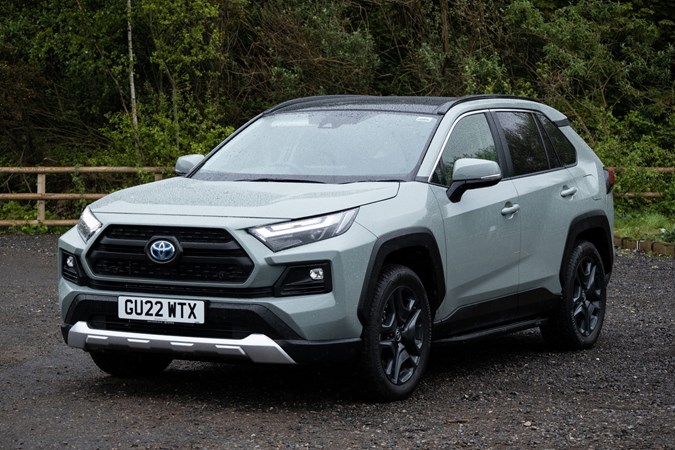
As is the way with most hybrids paired with a CVT, when you put your foot down acceleration is smooth with far less of the delay that you’d get with other automatic gearboxes. The main issue is that it results in quite an intrusive din coming from the engine bay, which spoils the overall refinement. It can end up sounding quite strained, especially as there are no gears for the automatic to go through. Still, it’s quieter than a Honda CR-V Hybrid and, because it’s quicker, you’ll find the sound can die down sooner in the Toyota.
Around town, the RAV4 defaults to driving on just battery power for short bursts, as long as you’re gentle on the accelerator. You’ll see a small green EV light in the instrument cluster to let you know it’s doing so. Overall, the RAV4 is a smooth and responsive performer. It’s not the kind of car to encourage enthusiastic driving, but it’s unlikely most potential buyers will be put off by this.
Using the same 2.5-litre as the regular Hybrid, the Plug-in version adds a bigger battery pack and an upgraded 182hp front motor, which increase the total power output to 306hp. It also boosts the car’s maximum electric range to around 46 miles. The rear, 40kW motor remains the same as the all-wheel-drive regular RAV4.
With a 0-62mph time of 6.0 seconds, the Plug-in is quite a bit quicker than the standard model, and feels quite different to drive. Despite those figures it’s actually more subdued, with the engine rarely asked to work hard to deliver a respectable pace. A bold drive mode dial on the centre console switches between Power, Normal and Eco modes, with the central dashboard display swapping between red, blue and green themes accordingly. Eco notably tames your inputs for more measured progress, but the car never feels slow.
The larger battery pack also improves the handling slightly, as it lowers the car’s centre of gravity. Sophisticated control of the motor’s output on the front and rear axles also helps to keep the chassis in check through the corners, but it’s hardly a hot hatchback. It’s entertaining to watch the nose rise when you hammer the throttle, but you can’t battle the laws of physics – and size isn’t on the RAV4’s side. If you want a sporty SUV, look elsewhere.
What’s it like to drive?
- Competent, but feels heavy at speed
- All-round visibility is good
- Off-road gadgets and 1,650kg towing capacity
If you’re not overly fussed with the ‘Sports’ part of Sports Utility Vehicle, then the RAV4 should prove an excellent place to spend your money. On twisty roads, it feels safe (as long as you don’t push it past its limits) – but the car shines on the motorway and around town.
It isn’t the biggest SUV on sale at the moment, but the RAV4 still feels fairly hefty on the road. Navigating through towns at low speeds isn’t so much a problem (thanks to good visibility and light steering), but you will notice its height and weight if you have to turn quickly on a country road.
The suspension feels soft all round, which means the front end dips noticeably when you have to use the grabby brakes in a hurry. Still, if you are on a twisty piece of road, the RAV4 doesn’t feel out of its depth – it’s just more suited to a leisurely pace, which feels appropriate for a hybrid SUV with incredibly light steering.
Regardless of what your intentions with the vehicle are, the electric all-wheel-drive system is well worth a look, not least because of the extra traction it delivers when accelerating. With 218hp on tap in the front-wheel-drive model, the RAV4 is hardly underpowered, and it does sometimes struggle to make a clean getaway when the road isn’t bone dry. The all-wheel-drive version, meanwhile, has no such issues, and might be the better choice for you if you live somewhere wetter. Like the Lake District. Or Wales.
The RAV4’s all-wheel-drive system uses a rear electric motor for additional traction, doing away with the transfer case and driveshaft of older models. In the regular hybrid, it’s essentially “extra power when traction is lost,” while in the plug-in hybrid it contributes more to the total output and functions in a way closer to a traditional 4x4 system. Trail Mode is designed to help out in more serious off-road situations where a driven wheel may lose contact with the ground. If this happens, the free rotating wheel will be braked, and the torque will instead be sent to the opposite wheel that’s in contact with the ground.




